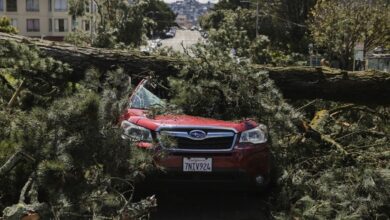What post-meal bloating means
Occasional flatulence after eating is usually not a cause for concern - especially if certain foods were previously on the menu. But if you have frequent flatulence after eating, you should get to the bottom of the cause.

Cabbage, onions, beans: Most people know that eating large amounts of them causes flatulence. Flatulence can also be triggered by many other foods, which is noticeable immediately or some time after eating.
When flatulence occurs after eating, this is usually harmless and has no clinical significance. In some cases, however, there is a disease behind it, for example a food intolerance. Depending on the cause, flatulence occurs after every meal or after eating certain foods.
Flatulence after eating from onions, lentils & co.
Anyone who eats legumes such as beans, lentils, chickpeas or peas must expect flatulence after eating. This is mainly due to the fiber it contains in the form of polysaccharides such as raffinose and stachyose. The small intestine cannot digest these, so they reach the large intestine “unprocessed”. Only there are they decomposed by bacteria from the intestinal flora – and various gases are released that are responsible for the flatulence.
Anyone who reacts strongly to legumes with flatulence does not necessarily have to do without it. There are a few ways to mitigate the gassy effect:
Discontinue use of soaking or canned water as it contains some of the gas-bloating ingredients.
Rinse legumes thoroughly after discarding the soaking or canning water.
Replace the cooking water halfway through the cooking time.
A little baking soda in the cooking water softens the legumes so that the intestines can digest them better.
Pureed lentils, beans or peas are easier to digest than whole fruits.
Spices such as caraway, fennel or savory can help prevent flatulence.
Onions and cabbage also often lead to flatulence after eating. They also contain a lot of fiber. For example, onions contain the dietary fiber inulin, but only in small amounts. Nevertheless, sensitive people can react with flatulence.
Whole Grains and Flatulence
Cereal products such as oatmeal or wholemeal bread also have plenty of fiber and are therefore difficult to digest. Dietary fiber is mainly found in the outer layers of cereal grains, so that foods made from whole grains in particular lead to problems. Some people suffer from gastrointestinal problems such as bloating or abdominal pain after eating large amounts. Especially people who are not used to a high-fiber diet react sensitively at first.
A lot of dietary fiber can be found in, for example
oatmeal
Whole grain bread
whole wheat pasta
brown rice
wheat bran
Good to know
Fiber is healthy. The German Society for Nutrition recommends a daily intake of at least 30 grams of dietary fiber. Anyone who has been consuming little fiber so far, but would like to eat more of it in the future, should start with small amounts. Then the intestines can slowly get used to the changed diet.
In addition to whole grain products and legumes, some types of fruit and vegetables also contain a lot of fiber, such as salsify, beans, carrots or artichokes.
Sugar (substitutes) and flatulence
Sugar and sugar substitutes can also cause bloating. Fruit or fruit juices contain high amounts of fruit sugar (fructose). In addition, fructose is added to many industrially produced foods. However, the small intestine can only process a limited amount of fructose. The rest is only broken down by bacteria in the large intestine – and this produces gases that escape through the anus as flatulence.
The sugar substitute sorbitol often leads to flatulence, especially in large quantities, as do the substances xylitol and mannitol. Sugars are commonly found in chewing gum, candy, and diet products.
Flatulence after eating from “swallowing air”
With each bite, a small amount of oxygen enters the digestive tract. Some people tend to swallow more air, which can promote flatulence – for example, because they have little time and eat their food hastily. It can help to chew each bite thoroughly and plan a little more time for the meal accordingly. Flatulence is also promoted by carbonated drinks. Still water or tea are therefore more suitable.
Flatulence after eating from illness
Various diseases can hide behind flatulence after eating. For example, an intolerance: many people cannot tolerate milk sugar (lactose). The cause is a deficiency in the enzyme lactase, which normally breaks down lactose in the small intestine. Experts speak of lactose intolerance. Typical symptoms are flatulence after eating foods containing lactose. Abdominal pain can also occur.
Gluten intolerance (celiac disease, sprue) can also cause flatulence after eating. Those affected react with an autoimmune reaction to the gluten protein. This is contained in many types of grain, for example in rye, wheat, barley or oats. Common symptoms include nausea, constipation, abdominal cramps, or bloating.
In addition, many other diseases can be accompanied by flatulence, which starts immediately after eating or with a delay. These include, for example:
Disorders of pancreatic function
surgical interventions in the area of the gastrointestinal tract, such as a (partial) removal of the stomach
tumors of the pancreas
Narrowing of the small or large intestine
(advanced) liver disease
Diseases of the bile ducts, such as gallstones, can also lead to digestive problems. Many of those affected then notice symptoms, for example after consuming coffee, alcohol or high-fat meals.
Flatulence after eating: what to do?
There are a few things you can do to reduce the chance of gas and bloating after eating. Anyone who is particularly sensitive to legumes or particularly high-fiber food with flatulence should use it sparingly or prepare the food in such a way that it is easier to digest. People who change their diet and want to eat more fiber, for example, should gradually get used to the digestive tract. Last but not least, take your time when eating.
In the case of an intolerance, the only thing that helps is to avoid the food in question and replace it with something else. If, for example, there is a gluten intolerance, other grains or grain alternatives such as millet, quinoa or buckwheat can be on the menu instead of wheat, rye & co.
Sometimes there is also no identifiable cause for flatulence after eating. If no physical reason can be found, experts speak of an irritable stomach or irritable bowel, depending on the symptoms.





